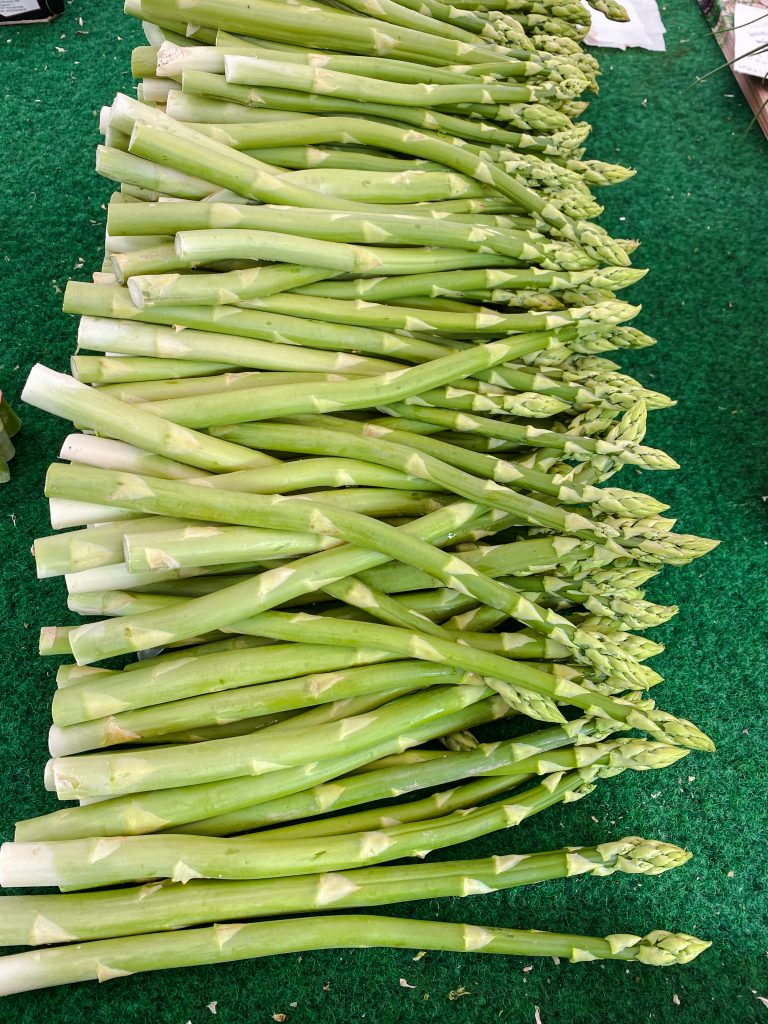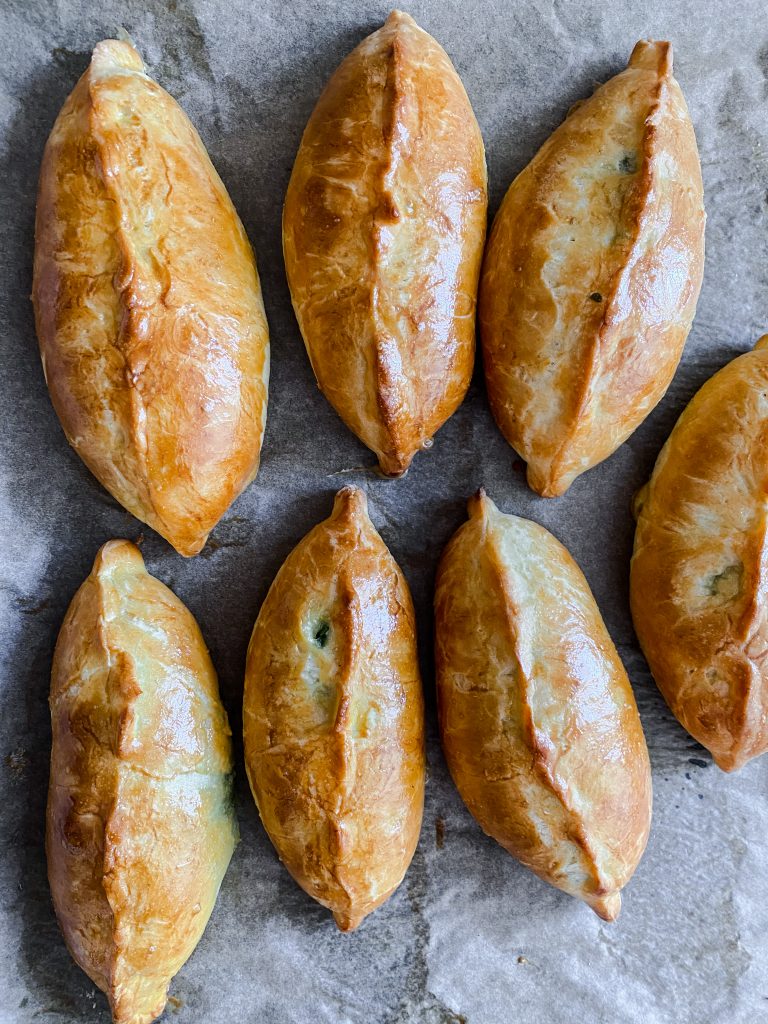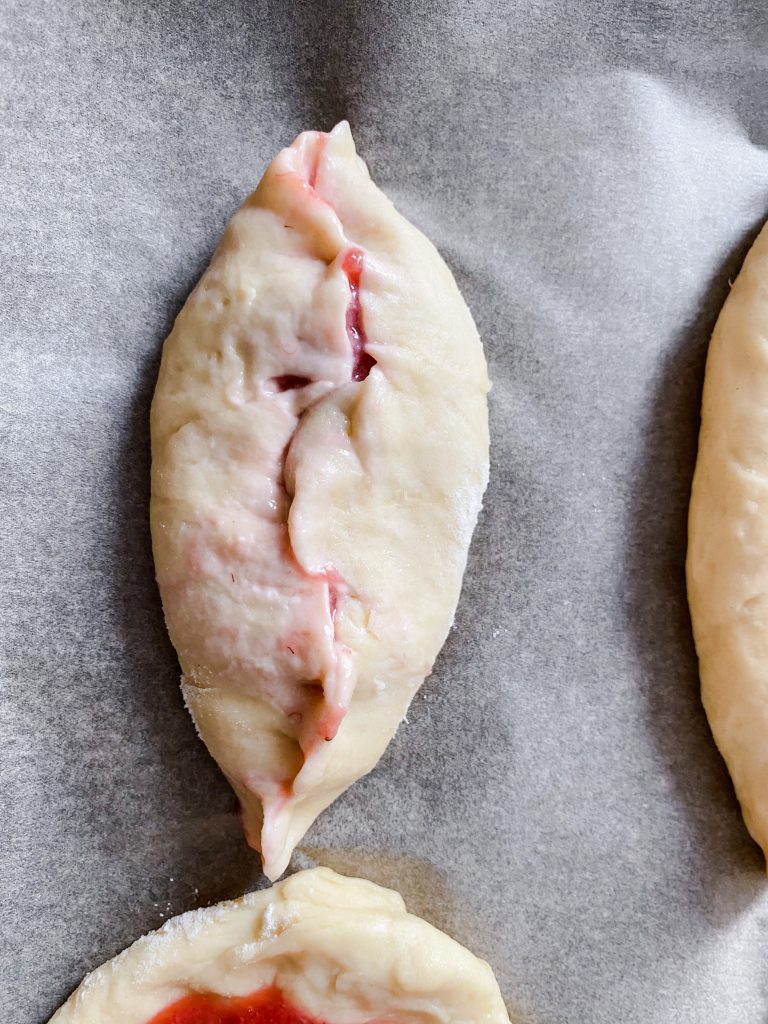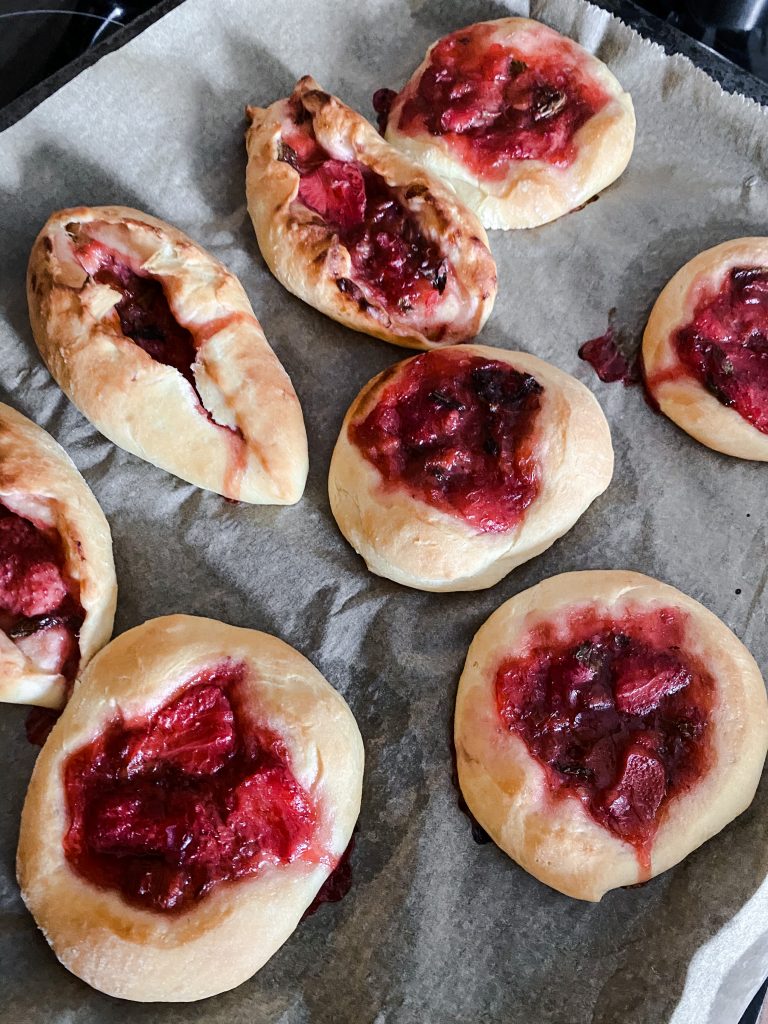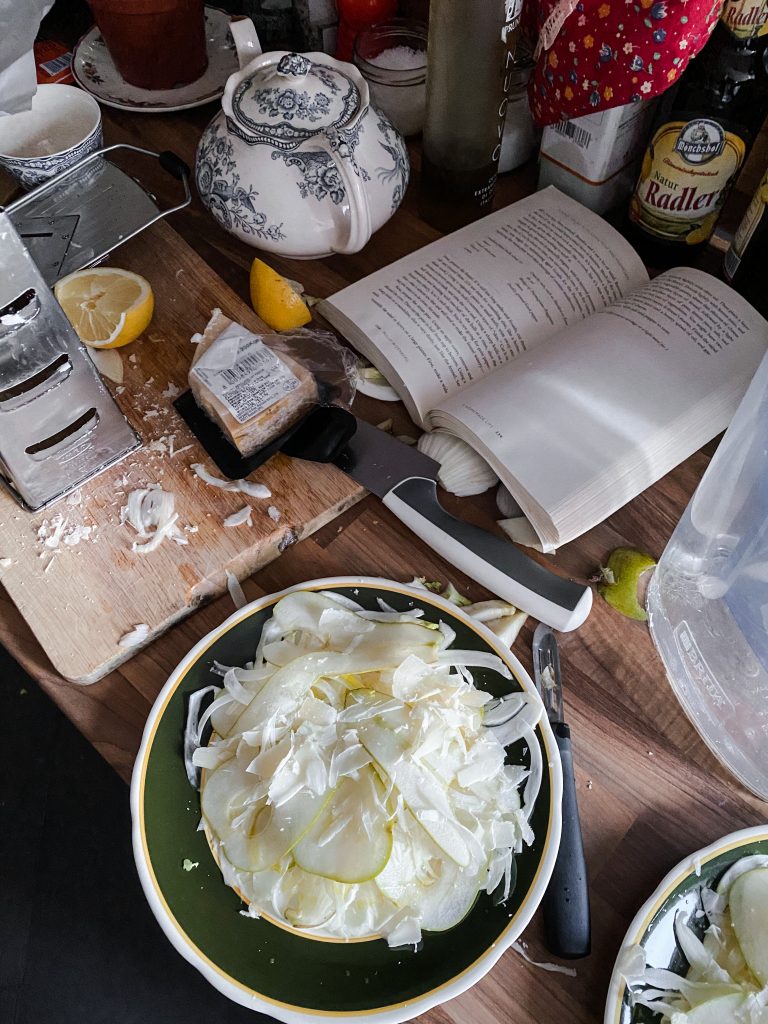We have come a full circle, who would have thought. Last May, when I first wrote about seasonal products I buy and all the things I cook with them, there was no other reason behind the idea than my urge to blabber.
It was the start of asparagus season in Germany and I was so excited (if not to say overwhelmed) by the bunches of green and white Spargel, the first juicy local strawberries and bright pink stalks of rhubarb that I sat down and rambled on for four pages. It was an exercise in writing whatever comes to my mind without thinking much of the structure, the metaphors, the importance of a cohesive conclusion. Who needed to read it I don’t know, but I had to write it.
I typed a full stop after almost two thousand words and thought: I have to write one of these every month now? It only makes sense, if the post is called “Seasonal Eating in May” to move on to June, July, August and all the way to the next April. And that’s where I find myself now, exactly a year later. And while some things did not change — I am eating white asparagus with ham, drinking rhubarb spritz and eating strawberries by the handful yet again — there’s been a shift in me. Not to sound all eat-pay-love-y here, but something within me gave way to allow more curiosity, spontaneity and confidence when it comes to food.
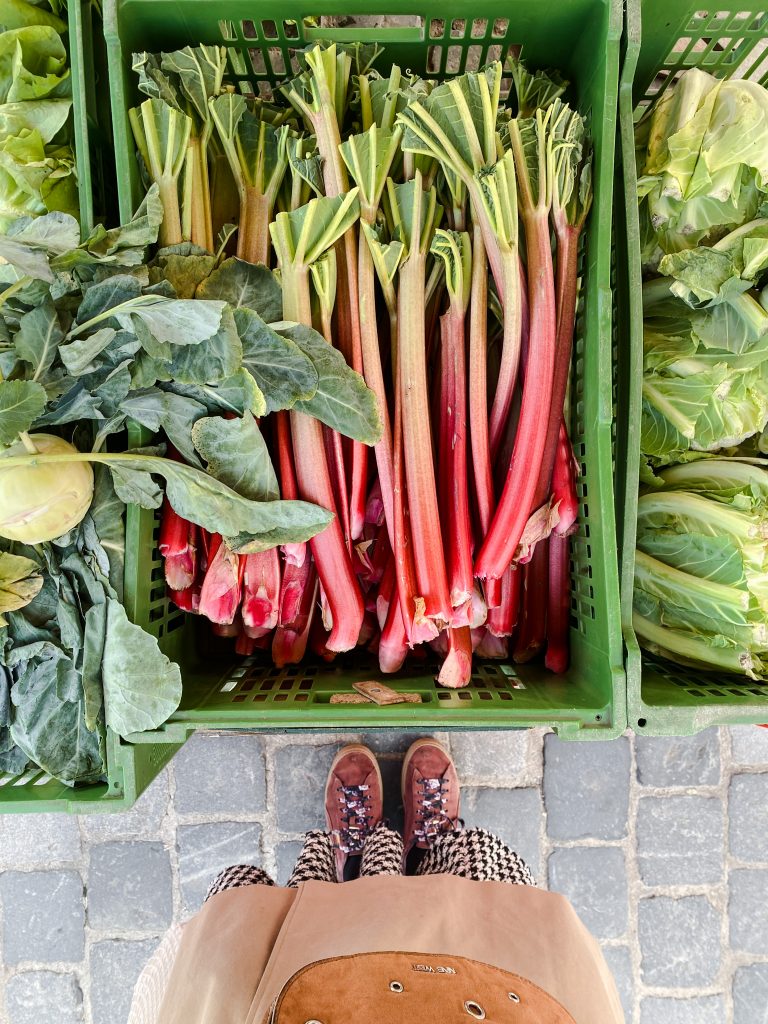
Instead of buying the bulk of my groceries at supermarkets, I started sourcing them from local farmers via two online markets I discovered shortly after starting this series. If I publicly declare that I am all about local and seasonal produce, I must go that extra mile, mustn’t I?
And because I wanted to bring some value to all the blabbering, I linked to the recipes I cooked every month by Ottolenghi, Diana Henry, Deb Perelman and many of my fellow food bloggers. And while that doesn’t sound like much, I assure you, it was no small feat. Not the linking, but the using the recipes. A year ago I was the kind of person who bought cook books occasionally and tried anywhere from zero to one recipe from each. Which is a little below average. Did you know that an average number of recipes someone cooks from a cookbook is two? But a year later I find myself buying cookbooks obsessively, reading them as novels and actually cooking through them.
Which, no wonder, led me to learning new techniques and trying unfamiliar ingredients. Something as well-known and wide-spread as celeriac, kohlrabi, and parsnip, for instance, were completely new to me. But there were also za’atar and sumac, black salsify and rutabaga, damsons and quinces, chestnuts and chestnut flour and so much more.
I found the courage to cook big and expensive chunks of meat — a fear I’ve had for at least a decade. I even cooked venison. It actually became a staple in my freezer, believe it or not. Maybe even more formidable than cooking deer was baking German Christmas cookies, for German cookies, just like the Germans themselves, are scary to approach, but sweet and soft once you dig in. I made seven varieties in the few weeks preceding the holidays, and, though I may sound obnoxious, I think my Elisenlebkuchen was better than the store-bought.
There were many failures, like the time I turned what was supposed to be quinces stuffed with lamb into inedible sour mush. Or the time I attempted to replicate my mom’s fried potatoes. Some failures just stayed so. I had to throw out the stuffed quinces, even though I redeemed myself later with a spiced quince and pomegranate jam. Other failures led to eventual success: I did nail the fried potatoes after a dozen tries.
But the most valuable outcome of this year is finally feeling confident enough to share my own recipes. In my August post, eight months ago, I dived into the topic of what qualifies one to develop and share recipes and why I don’t feel eligible. In the end of the post I gave myself permission to write more about food than travel. However, it’s one thing to declare something and completely different to actually feel it. It took me another seven months of cooking new and unfamiliar, of buying cookbooks, of writing my monthly reports to finally add a button “recipes” in the menu of my blog. Last month I have published eight recipes, about as many as I posted in the five years of blogging combined.
It feels good to have kept my word and have written twelve posts, one for every month. And it feels equally good to not have this obligation anymore. If you enjoyed reading these, do subscribe to my newsletter. It’s called “3-2-1, but make it food” and modeled after James Clear’s newsletter. Only instead of inspirational thoughts and quotes I share 3 seasonal recipes I am cooking this month, 2 new ingredients I am using and 1 book on food I highly recommend. On this note, I should stop rambling and actually tell you what I cooked in April.
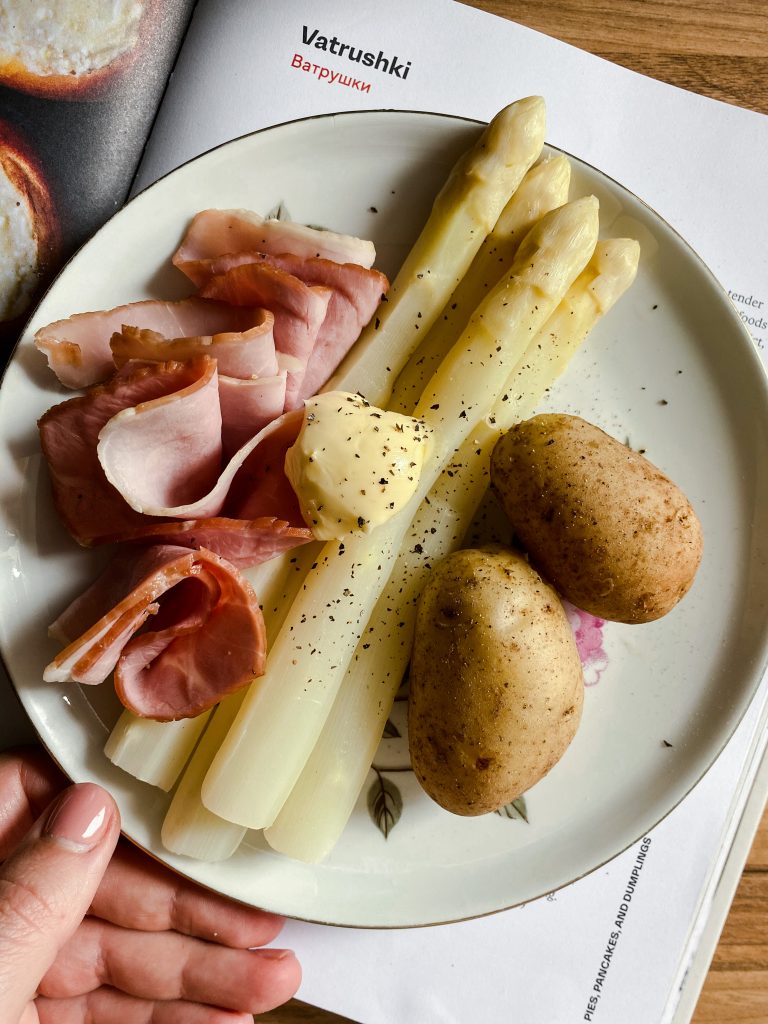
Let’s start with white asparagus, shall we? The season is short, so I take full advantage of it. Besides, asparagus is one of the easiest meals to make, simply boiled in water with a little bit of sugar, salt and butter, then paired with ham, new potatoes, and butter, or try it with Béarnaise sauce if you are feeling fancy.
It is equally great with pesto, in my case wild garlic pesto.
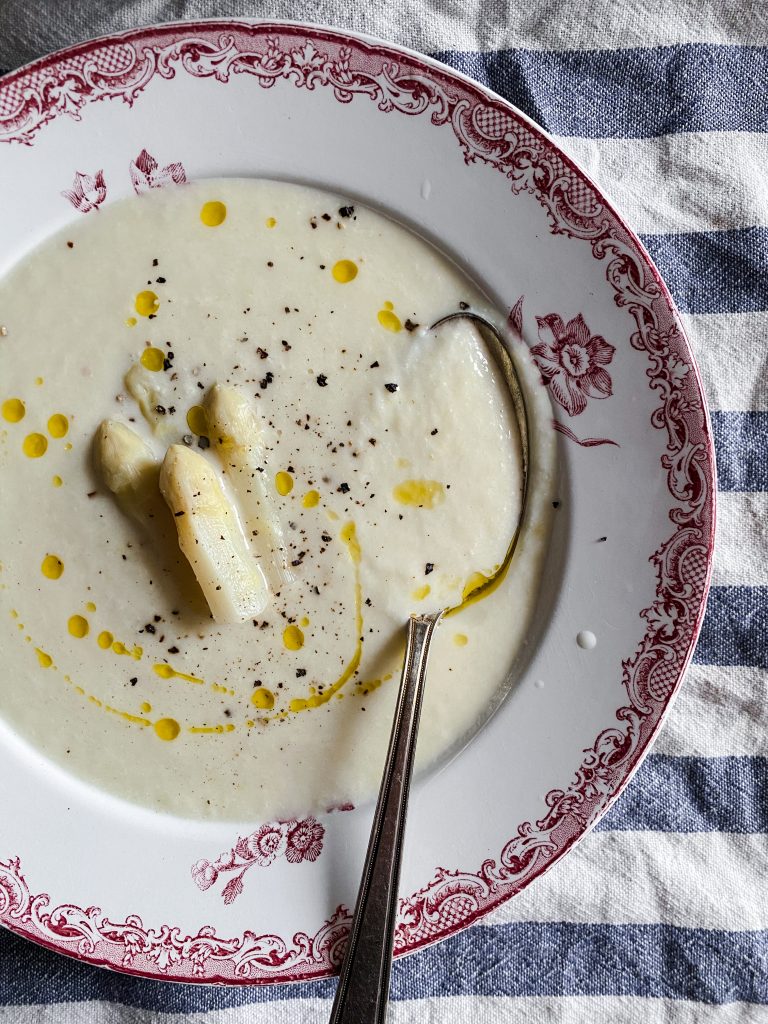
And in soup, of course. This is how this whole story with seasonal eating started a year ago — with white asparagus soup, recipe courtesy of Christie Dietz from A Sausage Has Two.
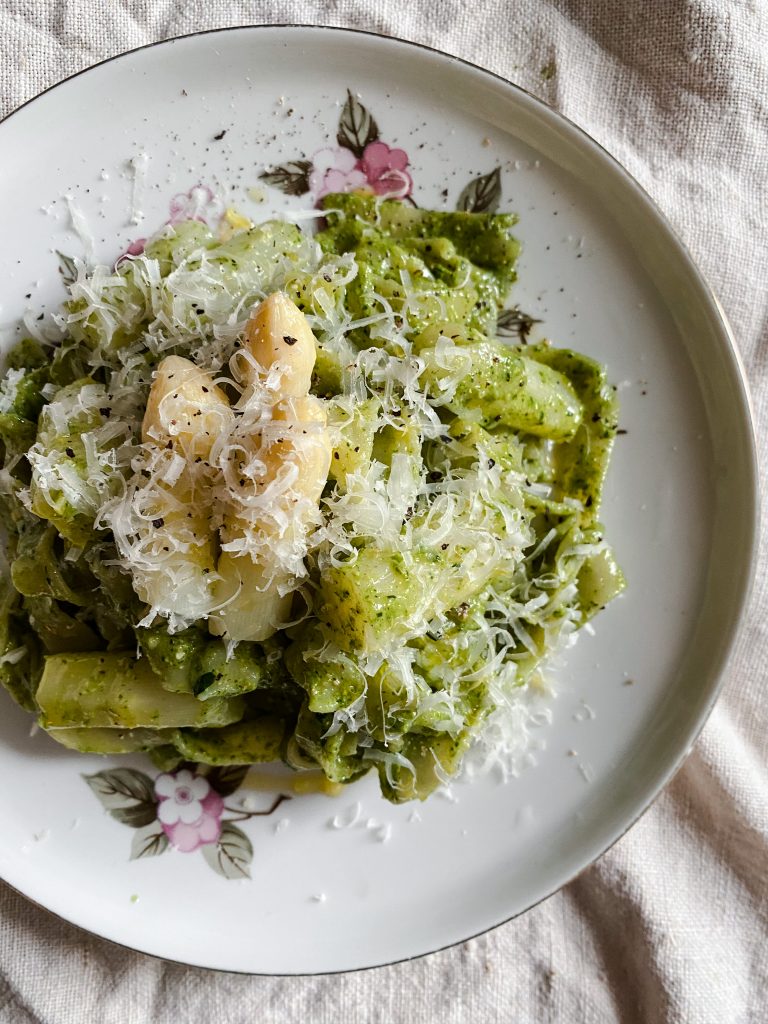
And let’s not forget about pasta with asparagus and wild garlic pesto (you guessed it, I made way too much pesto and had to put it into everything).
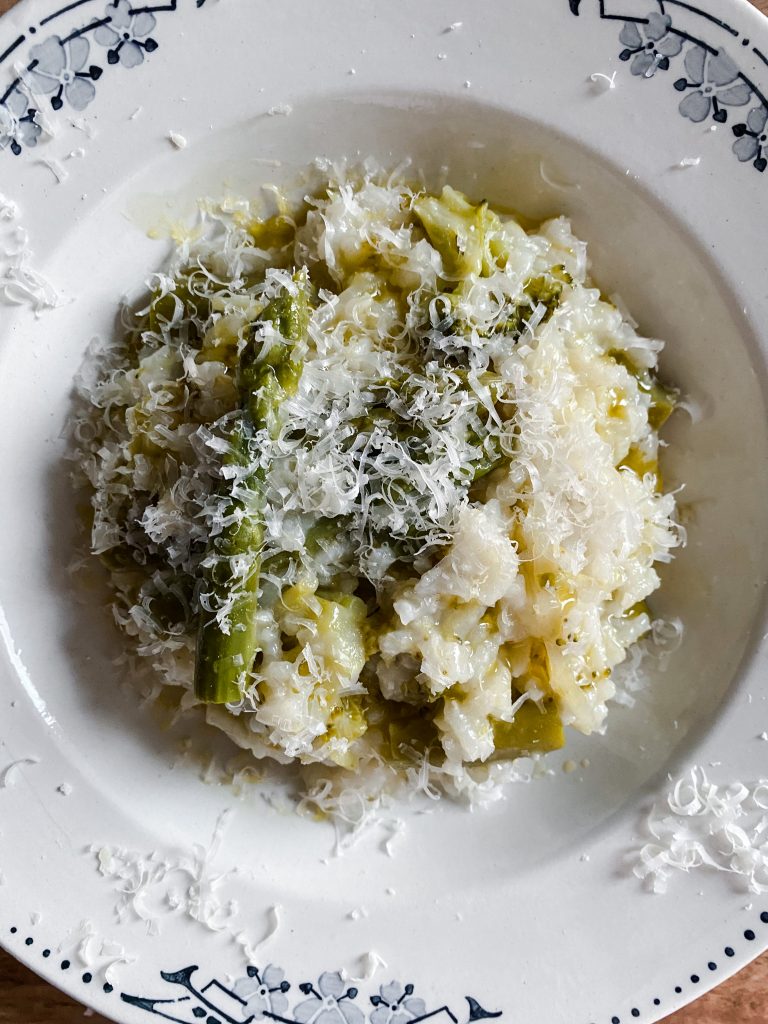
Then, of course, there’s green asparagus and an ocean of possibilities, but I went the familiar way and prepared risotto with asparagus and broccoli. I did’t use a recipe, but this NYT risotto with asparagus and pesto looks really good and easy, if you’d like to make something similar (possible paywall).
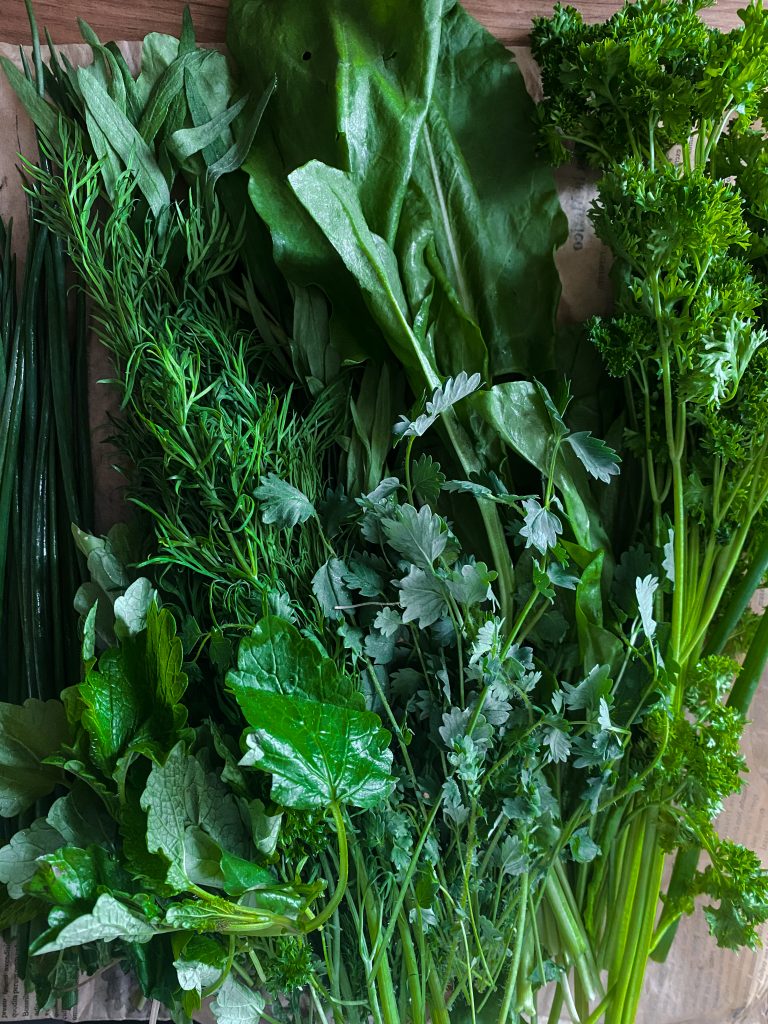
While we are on the topic of all things green, I’ve also prepared the famous Frankfurter Grüne Soße, Frankfurt green sauce. It’s made of seven specific herbs (sorrel, chervil, chives, parsley, burnet, cress and borage) which must be grown in or around Frankfurt for the sauce to be called Frankfurter Grüne Soße.
However, I live in Nuremberg and sourced my herbs here, so technically I made your average green sauce, not Frankfurt green sauce, but that’s not the point. The point is that the sauce was delicious, but at the same time I could not eat it. No more than a tablespoon anyways, as it was incredibly rich and heavy. Apart from the herbs, the ingredients include cream and — wait for it — boiled eggs! And guess what? Then you serve the sauce made of boiled eggs with boiled eggs. Wild! I am happy I tried this classic, but probably won’t make it again.
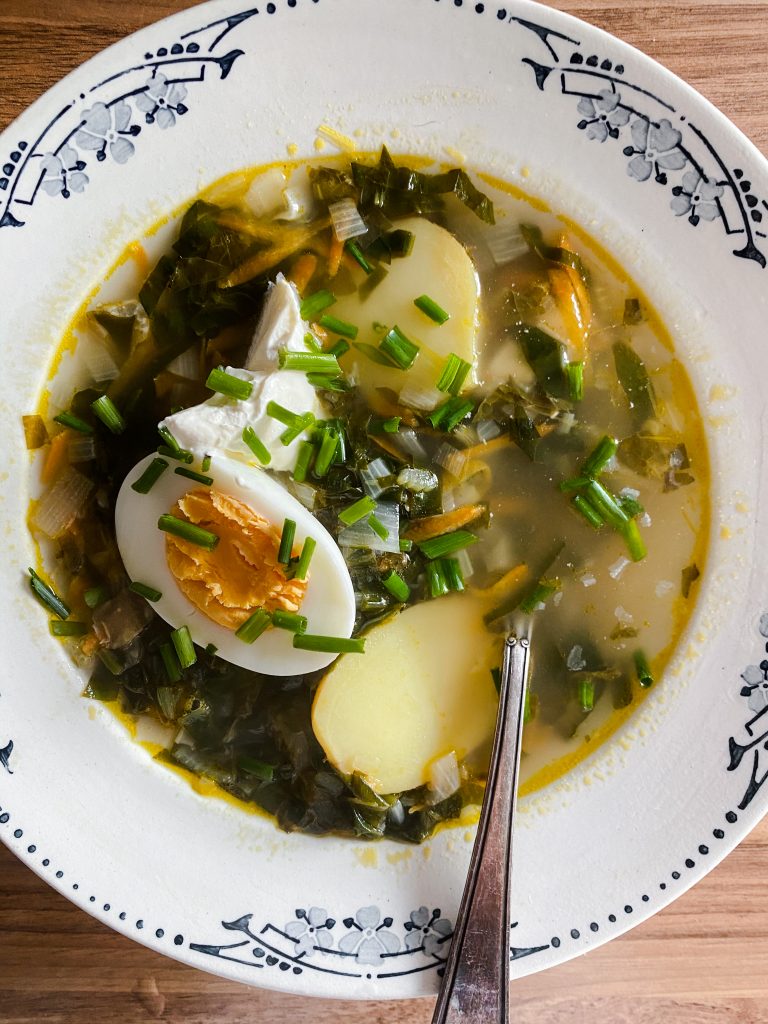
Russian green shchi, however, is something I cooked several times in the past few weeks. It must be the start of spring, but a lot of my food was green in April. Green shchi is named so because sorrel and nettle are used as substitutes for cabbage. I couldn’t get my hands on nettle, but sorrel and wild garlic worked just great. The recipe is coming to the blog soon, meanwhile here’s one for lazy shchi with cabbage.
To go on with the theme of green-colored food, I baked pirozhki (hand-pies) with spring onions, wild garlic, and eggs. Pirozhki are made of enriched dough and stuffed with all kinds of fillings from mashed potatoes to mushrooms to berries. Spring onion and egg is one of the most popular fillings that reminds me of train journeys across Russia when one buys pirozhki from babushkas (grandmas) at the train stations.
Inspired by my success with spring onion pirozhki I decided to make some with sweet filling too. Strawberry rhubarb jam seemed like a good idea until I started to fill the dough and the jam leaked out all over the baking tray. I baked them anyways. Somehow, once I took the tray out of the oven, pirozhki looked even worse, almost inappropriate, I’d say. They were delicious, though, just hideous. As you see, failures still happen, abundantly.
The leftover strawberries went into a filling for blini. I mashed them to release juices and mixed with tvorog (Russian-style cottage cheese). Blinchiki with tvorog and strawberries make for a perfect breakfast or dessert and can be frozen for later.
Finally, fennel made an appearance twice in April. To think that a year ago I had no idea what to make of it! Raw fennel, sliced thinly, makes the most amazing base for salads. I use a mandolin, the best investment I have made lately, but you could use a sharp knife too.
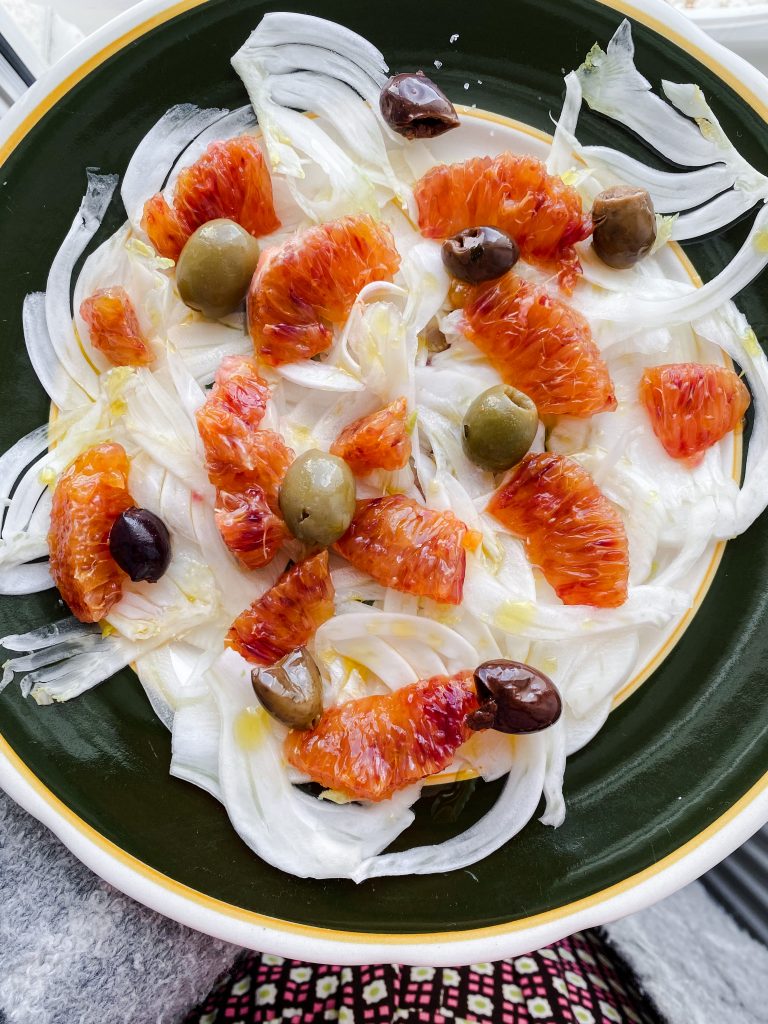
The first option is a fennel salad with orange and olives, a classic Italian dish. The only annoying thing is that you should remove all the connective membranes from orange segments, but otherwise the salad is done in 5 minutes.
The second one is a fennel salad with pears and parmesan – the recipe is from Molly Wizenberg’s A Homemade Life. Slice the fennel bulb and the pear thinly on a mandolin and shave parmesan on a grater. Both salads are dressed with extra virgin olive oil, some lemon juice and flakey salt.
And this was April! I have done it! We have done it! Now back to the kitchen to test and try and write. Thank you for following along on this journey of mine. Onwards!




